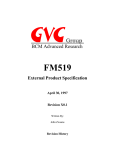Download Gigabyte GA-686LX motherboard
Transcript
GA - 686LX USER'S MANUAL Pentium II Processor MAINBOARD REV. 1 First Edition GA-686LX The author assumes no responsibility for any errors or omissions which may appear in this document nor does it make a commitment to update the information contained herein. Third-party brands and names are the property of their respective owners. SEPTEMBER 03, 1997 Taipei, Taiwan 2 Table of Contents TABLE OF CONTENTS 1. INTRODUCTION .............................................................................................................1-1 1.1. PREFACE ..................................................................................................................1-1 1.2. KEY FEATURES .......................................................................................................1-1 1.3. PERFORMANCE LIST ..............................................................................................1-2 1.4. BLOCK DIAGRAM.....................................................................................................1-3 1.5. INTRODUCE THE Pentium II Processor................................................................1-3 2. SPECIFICATION .............................................................................................................2-1 2.1. HARDWARE..............................................................................................................2-1 2.2. SOFTWARE ..............................................................................................................2-2 2.3. ENVIRONMENT ........................................................................................................2-2 3. HARDWARE INSTALLATION ........................................................................................3-1 3.1. UNPACKING .............................................................................................................3-1 3.2. MAINBOARD LAYOUT .............................................................................................3-2 3.3. QUICK REFERENCE FOR JUMPERS & CONNECTORS......................................3-2 3.4. DRAM INSTALLATION .............................................................................................3-4 3.5. CPU SPEED SETUP.................................................................................................3-5 3.6. CMOS RTC & ISA CFG CMOS SRAM .....................................................................3-5 3.7. SPEAKER CONNECTOR INSTALLATION..............................................................3-6 3.8. HARDWARE RESET SWITCH CONNECTOR INSTALLATION ............................3-6 3.9. POWER LED CONNECTOR INSTALLATION.........................................................3-6 3.10. GREEN LED INSTALLATION.................................................................................3-6 3.11. IDE & ATAPI DEVICE INSTALLATION ..................................................................3-6 3.12. PERIPHERAL DEVICE INSTALLATION ................................................................3-6 3.13. KEYBOARD & PS/2 MOUSE INSTALLATION .......................................................3-7 3.14. KEYBOARD SETTING FUNCTION........................................................................3-7 4. BIOS CONFIGURATION.................................................................................................4-1 4.1. ENTERING SETUP...................................................................................................4-1 3 GA-686LX 4.2. CONTROL KEYS.......................................................................................................4-2 4.3. GETTING HELP ........................................................................................................4-3 4.3.1. Main Menu ......................................................................................................4-3 4.3.2. Status Page Setup Menu / Option Page Setup Menu .....................................4-3 4.4. THE MAIN MENU ......................................................................................................4-3 4.5. STANDARD CMOS SETUP MENU..........................................................................4-5 4.6. BIOS FEATURES SETUP.........................................................................................4-9 4.7. CHIPSET FEATURES SETUP .................................................................................4-13 4.8. POWER MANAGEMENT SETUP ............................................................................4-14 4.9. PNP/PCI CONFIGURATION.....................................................................................4-20 4.10. INTEGRATED PERIPHERALS...............................................................................4-22 4.11. LOAD SETUP DEFAULTS......................................................................................4-27 4.12. USER PASSWORD ................................................................................................4-28 4.13. IDE HDD AUTO DETECTION ................................................................................4-29 4.14. HDD LOW LEVEL FORMAT...................................................................................4-29 4.15. SAVE & EXIT SETUP..............................................................................................4-30 4.16. EXIT WITHOUT SAVING........................................................................................4-32 5. AT TECHNICAL INFORMATION....................................................................................5-1 5.1. I/O BUS CONNECTOR PIN OUT .............................................................................5-1 5.1.1. ISA SLOT PIN OUT .......................................................................................5-1 5.1.2. PCI - BUS SLOT PIN OUT ............................................................................5-2 5.2. I/O & MEMORY MAP.................................................................................................5-3 5.3. TIMER & DMA CHANNELS MAP .............................................................................5-3 5.4. INTERRUPT MAP .....................................................................................................5-4 5.5. RTC & CMOS RAM MAP ..........................................................................................5-5 APPENDIX A: POST MESSAGE........................................................................................A-1 APPENDIX B: POST CODES .............................................................................................B-1 APPENDIX C: BIOS DEFAULT DRIVE TABLE .................................................................C-1 APPENDIX D: PROBLEM SHEET......................................................................................D-1 4 Table of Contents APPENDIX E: FCC DOCUMENT........................................................................................E-1 5 Introduction 1. INTRODUCTION 1.1. PREFACE Welcome to use the GA - 686LX motherboard. The motherboard is a Pentium II Processor based PC / AT compatible system with AGP / PCI / ISA Bus, and has been designed to be the fastest PC / AT system. There are some new features allow you to operate the system with just the performance you want. This manual also explains how to install the motherboard for operation, and how to set up your CMOS CONFIGURATION with BIOS SETUP program. 1.2. KEY FEATURES q Intel Pentium II Processor based PC / AT compatible mainboard. q Slot 1 supports Pentium II processor running at 233-633 MHz. q Intel 440LX chipset, Support AGP / SDRAM / Ultra DMA/33 IDE / ACPI features. q Support CPU FAN Failure / Overheat Alarm & auto slow down CPU speed. q Support Intel LDCM Network Manageability. q Supports 4xDIMMs using 3.3V EDO or SDRAM DIMM module. q Supports 8 MB - 1 GB EDO / 512MB SDRAM memory on board. q Supports ECC or Non-ECC type DRAM module. q 1xAGP slot, 4xPCI Bus slots, 3xISA Bus slots. q Supports 2 channels Ultra DMA/33 IDE ports for 4 IDE Device. q Supports 2xCOM (16550), 1xLPT (EPP / ECP), 1x1.44MB Floppy port. q Supports 2xUSB ports, 1xPS/2 Mouse & 1xPS/2 Keyboard ports. q Licensed AWARD BIOS, 2M bit FLASH RAM. 1-1 GA-686LX q ATX form factor, Double stack I/O connector, 4 layers PCB. 1.3. PERFORMANCE LIST The following performance data list is the testing results of some popular benchmark testing programs. These data are just referred by users, and there is no responsibility for different testing data values gotten by users. (The different Hardware & Software configuration will result in different benchmark testing results.) • CPU Pentium II processor • DRAM 64 MB SDRAM • CACHE SIZE 512 KB included in CPU • DISPLAY Matrox Millennium II 4MB PCI VGA • STORAGE Onboard IDE port • O.S. Windows95 OSR2.0. • DRIVER Display Driver at 1024 x 768 x 64K colors x 75Hz. Triones Bus Master IDE Driver 3.60K Intel Pentium II Processor 266MHz Winbench97 CPU mark32 Business Disk Hi-End Disk Business Graphic Hi-End Graphic 697 2210 5890 116 50.8 Winstone 97 Business 62 1-2 300MHz 783 2260 6490 127 56.3 64.9 Introduction Hi-End 30.6 32.6 1.4. BLOCK DIAGRAM AGP SLOT 3.3V EDO/SDRAM DIMM Sockets Host Bus SLOT1 AGP Bus PAC 82443LX CHIPSET DRAM Bus PCI Bus 33MHz 66MHz 66MHz CLOCK GEN SC652EY B 33MHz Ultra DMA/33 IDE Ports 33MHz 14.318MHz PCI Bus IDE Bus 8MHz 48MHz PIIX4 82371AB CHIPSET 66MHz 14.318MHz 66MHz 24MHz USB Bus USB #1 ISA Bus USB #2 COM Ports I/O 8661 CIPSET LPT Port Floppy Port PS/2 Keyboard KBC 8042 ISA Slots 1-3 PS/2 Mouse 14.318MHz GA-686LX 1.5. INTRODUCE THE Pentium II Processor & AGP Figure 1:Retention Mechanism & attach Mount Figure 2:OEM Pentium II Processor 1-4 Introduction Figure 3:Heatsink / FAN & Heat sink support for OEM Pentium II Processor Figure 4:Boxed Pentium II Processor & Heat sink support 1-5 GA-686LX What is AGP? The Accelerated Graphics Port (AGP) is a new port on the Host-To-PCI bridge device that supports an AGP port. The main purpose of the AGP port is to provide fast access to system memory. The AGP port can be used either as fast PCI port (32-bit at 66MHz vs. 32-bits at 33MHz) or as an AGP port which supports 2x data-rate, a read queue, and side band addressing. When the 2x-data rate is used the port can transmit data at 533Mb/sec (66.6*2*4). The read-queue can be used to pipeline reads – removing the effects of the reads-latency. Side band addressing can be used to transmit the data address on a separate line in order to further speed the transaction. 1-6 Specification 2. SPECIFICATION 2.1. HARDWARE • CPU − Pentium II processor 233 – 633 MHz. − 242 pins 66MHz slot1 on board. • PROTECTION − Onboard Buzzer Alarm when detect "CPU FAN Failure" or “ CPU Overheat” . − Automatically slow down CPU speed when "CPU FAN Failure" or "CPU Overheat". − Intel LDCM support. − H/W monitor power status (±5V, ±12V, CPU voltage & CMOS battery voltage). • SPEED − 66 MHz system speed. − 66 MHz AGP bus speed. (133MHz 2*mode) − 33 MHz PCI-Bus speed. − 8 MHz AT bus speed. • DRAM MEMORY − 4 banks 168 pins DIMM module sockets on board. − Use 8 / 16 / 32 / 64 / 128 / 256 MB 60~70 ns DIMM module DRAM. − 8 ~ 1 GB DRAM size. − Support 3.3V SDRAM / EDO type DRAM. − Support ECC or Non-ECC type DRAM. • CACHE MEMORY − 32 KB 1st cache memory included in CPU. − 256KB/512 KB 2nd cache in CPU. − Support DIB speed mode for L2 Cache. − 1 66MHz / 133MHz AGP bus. • I/O BUS SLOTS − 4 33MHz Master / Slave PCI-BUS. − 3 8MHz 16 bits ISA BUS. • IDE PORTS − 2 Ultra DMA/33 Bus Master IDE channels on board.(Using IRQ14,15) − Back ward Support Mode 3,4 IDE & ATAPI CD - ROM. 2-1 GA-686LX • I/O PORTS − Supports 2 16550 COM ports. (Using IRQ4, 3) − Supports 1 EPP/ECP LPT port. (Using IRQ7 or 5 and DMA3 or 1) − Supports 1 1.44/2.88 MB Floppy port. (Using DMA2 & IRQ6) − Supports 2 USB ports. − Supports PS/2 Mouse. (Using IRQ12 ) − Supports PS/2 Keyboard. (Using IRQ1 ) • GREEN FUNCTION − Suspend mode support. − Green switch & LED support. − IDE & Display power down support. − Monitor all IRQ / DMA / Display / I/O events. • BIOS − 256KB FLASH EEPROM. • DIMENSION − ATX Form Factor, 4 layers PCB. 2.2. SOFTWARE • DRIVER − Intel LDCM optional. − Supports Plug & Play, DMI, ACPI Function. − Health monitor Utility. − Bus Master IDE Driver • BIOS − Licensed AWARD BIOS. − AT CMOS Setup, BIOS / Chipset Setup, Green • O.S. Setup, Hard Disk Utility included. − Monitor Health status. − Operation with MS-DOS, Windows95, WINDOWS NT, OS/2, NOVELL and SCO UNIX. 2.3. ENVIRONMENT • Ambient Temp. • Relative Hum. • Altitude • Vibration • Electricity − 0°C to +50°C (Operating). − 0 to +85% (Operating). − 0 to 10,000 feet (Operating). − 0 to 1,000 Hz. − 4.9 V to 5.2 V. − Max. 20A current at 5V. 2-2 Hardware Installation 3. HARDWARE INSTALLATION 3.1. UNPACKING The mainboard package should contain the following: • The GA - 686LX mainboard. • The Retention Mechanism & Attach Mount • USER'S MANUAL for mainboard. • Cable set for IDE & Floppy device. • Diskette or CD for Mainboard Utility. The mainboard contains sensitive electric components, which can be easily damaged by static electricity, so the mainboard should be left in its original packing until it is installed. Unpacking and installation should be done on a grounded anti-static mat. The operator should be wearing an anti static wristband, grounded at the same point as the anti-static mat. Inspect the mainboard carton for obvious damage. Shipping and handling may cause damage to your board. Be sure there are no shipping and handling damages on the board before proceeding. After opening the mainboard carton, extract the system board and place it only on a grounded anti-static surface component side up. Again inspect the board for damage. Press down on all of the socket IC's to make sure that they are properly seated. Do this only on with the board placed on a firm flat surface. M DO NOT APPLY POWER TO THE BOARD IF IT HAS BEEN DAMAGED. You are now ready to install your mainboard. The mounting hole pattern on the mainboard matches the ATX system board. It is assumed that the chassis is designed for a standard ATX mainboard mounting. Place the chassis on the anti-static mat and remove the cover. Take the clips, stand-off and screws for mounting the system board, and keep them 3-1 GA-686LX separate. 3.2. MAINBOARD LAYOUT CN1COMA COMBCN2 LPT CN3 USB KB Mouse CN4 CN5 J1 HT1 J2 FAN POWER JP2 PCI4 PCI3 PCI2 PCI1 BUZZER1 SLOT6 SLOT4 AGP1 371AB PIIX4 SLOT2 BIOS 4 3 2 1 RESET SPEAKER J3 Bank 3 Bank 2 Bank 1 Bank 0 DIMM4 DIMM3 DIMM2 DIMM1 BAT1 S1 HD-LED IR J6 J7 J1 J5 ATX POWER1 GA-686LX GN-SW PWR-ON J8 J9 CN6 IDE2 CN7 IDE1 FLOPPY PWR-LED ×Figure 3.1Ø 3.3. QUICK REFERENCE FOR JUMPERS & CONNECTORS t t CN1-8 I/O Ports Connector CN1 For Serial port1 (COM A). CN2 For Serial port2 (COM B). CN3 For LPT port. CN4 USB port. CN5 For Keyboard I/O port. CN5 For PS/2 Mouse port. CN6 For Secondary IDE port. CN7 For Primary IDE port. CN8 For Floppy port J1: slot1 3-2 CN8 Hardware Installation For Pentium II processor installed. t J2: CPU cooling FAN Power Connector Pin No. Function 1 GND. 2 +12V 3 SENSE t J3: SPEAKER Connector Pin No. 1 VCC 2 NC. 3 NC. 4 Output t t Function J4: RESET Switch Pin No. 1 RESET Input 2 GND Function J5: POWER ON LED (PW-LED) Pin No. 1 LED POWER (+) 2 NC 3 GND (-) Function t J6: Hard Disk active LED (HD-LED) Pin No. Function 1 LED POWER (+) 2 LED POWER (-) 3 NC 4 LED POWER (+) t J7: INFRARED Connector (IR) -- Function Option Pin No. Function 1 IR Data Output 2 GND 3 IR Data Input 4 NC 3-3 GA-686LX 5 POWER (+) t J8: GN-SW On – Off for enter suspend Green Mode. t J9: Soft Power Switch On – Off for POWER ON or Suspend IN / OUT. On 4 sec. For POWER OFF before VGA Enable or CMOS setup select “ delay 4sec.” For POWER OFF mode. t t J10: Green LED OFF Normal mode ON Suspend mode S1: CPU INT. / EXT. FREQ. RATIO CPU TYPE 1 2 200MHz OFF ON 233MHz ON ON 266MHz OFF OFF 300MHz ON OFF 333MHz OFF ON 366MHz ON ON 3 OFF OFF ON ON ON ON 4 OFF OFF OFF OFF OFF OFF CLK RATIO X3 X3.5 X4 X4.5 X5 X5.5 t POWER1: ATX POWER connector Pin No. Function 3,5,7,13,15GND 17 4,6,19,20 VCC (+5V) 10 +12V 12 -12V 18 -5V 8 Power Good 9 5V SB (Stand by +5V) 14 PS-ON (Soft ON/OFF) 3.4. DRAM INSTALLATION The mainboard can be installed with 4 / 8 / 16 / 32 / 64 / 128 / 256 MB 168 pins DIMM module DRAM, and the DRAM speed must be 50 or 60 ns for 3-4 Hardware Installation EDO & 67~100 MHz for SDRAM. The DRAM memory system on mainboard consists of bank 0, 1, 2 & bank 3. Each bank consists of 3 PCS 168 pins DIMM module DRAM. Because the 168 pins DIMM module is 64 bits width, using 1 PCS which can match a 64 bits system. The total memory size is 8 MB ~ 1 GB EDO / 512MB SDRAM. The DRAM installation position refer to Figure 3.1, and notice the Pin 1 of DIMM module must match with the Pin 1 of DIMM socket. Insert the DRAM DIMM module into the DIMM socket at Vertical angle. If there is a wrong direction of Pin 1, the DRAM DIMM module couldn't be inserted into socket completely. 3.5. CPU SPEED SETUP The system's speed is fixed to 66.6MHz. The user can change the DIP SWITCH (S1) selection to set up the CPU speed for 233 - 633MHz processor. The CPU speed must match with the frequency RATIO. It will cause system hanging up if the frequency RATIO is higher than CPU's. DIP SWITCH (S1) FREQ. EXT.CLK. NT.CLK. RATIO MHz MHz OFF 3 66 200 Pentium II 200 MHz OFF OFF 3.5 66 233 Pentium II 233 MHz OFF ON OFF 4 66 266 Pentium II 266 MHz ON OFF ON OFF 4.5 66 300 Pentium II 300 MHz OFF ON ON OFF 5 66 333 Pentium II 333 MHz ON ON ON OFF 5.5 66 366 Pentium II 366 MHz 1 2 3 4 OFF ON OFF ON ON OFF CPU Type M The CPU is a sensitive electric component and it can be easily damaged by static electricity, so users must keep it away from metal surface when the CPU is installed onto mainboard. 3.6. CMOS RTC & ISA CFG CMOS SRAM There're RTC & CMOS SRAM on board; they have a power supply from external battery to keep the DATA inviolate & effective. The RTC is a REALTIME CLOCK device, which provides the DATE & TIME to system. The CMOS SRAM is used for keeping the information of system configuration, so 3-5 GA-686LX the system can automatically boot OS. every time. Due to the life-time of Battery internal battery is 5 years, the user can change a new Battery to replace old one after it can not work. 3.7. SPEAKER CONNECTOR INSTALLATION There is always a speaker in AT system for sound purpose. The 4 - Pins connector J3 is used to connect speaker. The speaker can work well in both direction of connector when it is installed to the connector J3 on mainboard. 3.8. HARDWARE RESET SWITCH CONNECTOR INSTALLATION The RESET switch on panel provides users with HARDWARE RESET function, which is almost the same as power-on/off. The system will do a cold start after the RESET switch is pushed and released by user. The RESET switch is a 2 PIN connector and should be installed to J4 on mainboard. 3.9. POWER LED CONNECTOR INSTALLATION There are system power LED lamps on the panel of case. The power LED will light on when system is powered-on, which is connected to a 3 PIN connector. The connector should be connected to J5 of mainboard in correct direction. 3.10. IDE & ATAPI DEVICE INSTALLATION There are two Enhance PCI IDE ports (CN6, 7) on board, which following ATAPI standard SPEC. Any one IDE port can connected to two ATAPI devices (IDE Hard Disk, CD-ROM & Tape Driver), so total four ATAPI devices can exist in a system. The booting Hard Disk should be the Master device of 1st IDE channel. The J6 is the active LED port for ATAPI device. 3.11. PERIPHERAL DEVICE INSTALLATION After the I/O device installation and jumpers setup, the mainboard can be mounted into the case and fixed by screw. 3-6




































